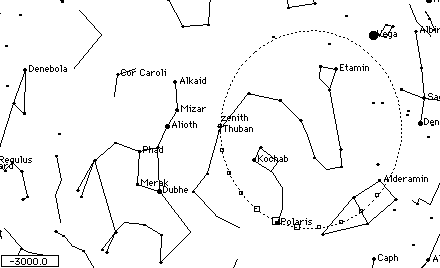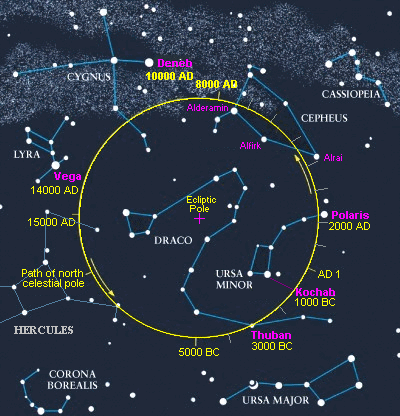Next up is 2012, this time due to one Meso-American calendar, and some speculation has been that the LHC will cause it, unleashing an army of Strangelets led by ancient Mayan overlords.
But then a rash of earthquakes happened more recently, and I postulate that the Mayans are in danger of being beaten out of End of the World honors by ... the Norse. Yet the Norse aren't getting much credit yet and I intend to change that.
Ancient astronomy
Astronomy has always been the sweet physical science, where everyone can have a meaningful impact regardless of position or funding. Urbain Jean Joseph Le Verrier discovered Neptune "with the point of his pen" and amateur astronomer Anthony Wesley of Canberra, Australia discovered a huge impact on Jupiter while NASA employees apparently drank coffee and griped about funding.
Astronomy goes back a lot farther than that. The Mayans were keen fans of astronomy and darn good at it, since they were able to calculate a winter solstice some 2300 years in the future. The Norse understood it as well. How is it relevant today?
First, let's talk about our planetary motion. Earth makes three different kinds of motion in space: The planet rotates around its axis, basically an imaginary pole but you get the idea, and that takes about 24 hours; it revolves around the Sun, which takes a bit over 365 days; and finally precession, which is the gradual turning of the Earth's axis and takes around 26,000 years.
What does that mean? The Earth's axis essentially traces out a cone and it does so because, as Newton showed us, our planet is an oblate spheroid (it bulges out at the Equator rather than being uniform) and gets torque applied by both the Sun and the Moon.
This 'precession of the equinoxes' is attributed to the Greek astronomer Hipparchus around 150 B.C. but both the Norse and the Mayans seem to have known about it, even if they didn't quite know what to call it.
How so?
There is actual science in the Zodiac
The Zodiac gets a bad rap today because kooks choosing to live their lives by it make people think the kookiness came first but there is a reason it made the universe sane for ancient civilizations.
Because the Earth is essentially 'wobbling' due to its irregular shape, even ancient astronomers noticed that the constellations in the Zodiac seemed to be moving (precessing) - to make sense of chaos they decided to break this precession into 12 periods, obviously based on the Zodiac they could see and the Constellation that the sun 'rose' in on the first day of Spring got the first honors; Pisces. So mankind has been in the Age of Pisces as the planet slowly wobbled around its axis.
But this wobbling takes around 26,000 years and there are 12 constellations in the Zodiac. Every 2,160 years, they surmised, the Sun will appear to be 1/12th of its way through the Zodiac. If Hipparchus was 150 B.C. then the Age of Pisces would become the Age of Aquarius(2) in ...
... 2010.

Earth's precession as seen from the North pole and changing over time. Credit: National University of Singapore
Yep, the planet is wobbling, we're entering a new Age and earthquakes are happening. Coincidence? Not if you are reading this article.
First, maybe all that spinning makes you dizzy. If so, here is a snapshot with a few handy dates.

The Precession of the N. Celestial Pole describes a huge counter-clockwise circle in the northern sky as seen from the Earth. The angular diameter of this circle is twice the tilt of Earth's axis - approximately 47° across. Credit: The Royal Astronomical Society of Canada
We know some people believe that the Mayans predicted the end of the world because one of their calendars, based on precession, ends on the Winter Solstice in 2012 - and we have to give them credit for being able to even calculate the Winter Solstice in 2012 - but 13 was a magic number to Mayans so it seems more likely that instead of going beyond 13 they would just have started over, like we do with days and months.
The Norse were a lot more serious than we are about starting over. They blew up stuff when Ages ended.
Ragnarok
The Norse were also no dummies. Millenia ago they knew that strange things were happening on a macro scale. When the Sun seemed to rise in the constellation at the Equinox positions, it was always the first day of Spring or Fall. When the Sun appeared to rise in the constellation of the Solstice, it was the first day of Summer or Winter.
And they also calculated that these Ages were changing every 2160 years - the Celestial Axis was represented by Yggdrasill, a huge ash tree in Asgard, where the Gods lived. It was the one thing that never seemed to die, even though everything else would in those transitions between Ages they called Ragnarok.
In Ragnarok, basically everything would be destroyed; by fiery explosions from the ground bringing clouds of death, by earthquake or, if you were really, really cool, by a giant serpent named Jörmungandr.

When Ragnarok comes, you will find out my true identity.
Except we will all only be mostly dead.
In Gylfaginning, chapter 52, Gangleri asks, "What will be after heaven and earth and the whole world are burned? All the gods will be dead, together with the Einherjar and the whole of mankind. Didn't you say earlier that each person will live in some world throughout all ages?"
Indeed we would. We might not look the same in this new Age. Instead of blonde, I might be red-headed and have a much larger beard for example. I might wear gloves. Hard to say.
How does all that relate to earthquakes? There has long been this fascinating idea with harmonic convergence, which basically says that planetary alignment will cause earthquakes, volcano eruptions - basically a whole bunch of what has been in the news this year.
Far be it from me to naysay the power of gravity. Planets are big and we know walking outside every day that Earth is being impacted by both gravity and the tidal force of the moon; gravity simply pulling on us and tidal force trying to 'stretch' us and making waves, etc. As Phil Plait, everyone's favorite Bad Astronomer puts it, a strong enough gravity "could pull the Earth from its orbit, while a strong enough tide could rip it in half." But it isn't happening because some planets are on the same side of the Sun, which actually happens fairly often.
The last time people were terribly worried about harmonic convergence was the same year everyone was worried about COBOL programmers; 2000. And we're still here. Basically, you shouldn't get your science from astrologers or psychics.
So back to 2010 versus 2012. The Norse were as cagey on this one as the Mayans because a lot is left up to interpretation and translation of ancient symbols is an imperfect science. If, as some scholars claim, the last Age ended 2160 years ago, the Norse will beat out the Mayans for World-Ending honors by killing us all this year - if you like your paranoid conspiracy tales and 2012 is too long to wait, that is pretty good reasoning to party now.
But other scholars claim that the last Ragnarok only occurred 2010 years ago - stating that Asgard on fire heralding in a new 'Age' of Gods in the last Ragnarok was the Star of Bethlehem(3), which means that we have another 150 years to wait.
What do you think?
I think one way or the other, those who predict the End of the World will eventually be right. After all, if the Norse or Mayans don't get us, maybe the Sumerians will.
NOTES:
(1) Over this cycle the Earth's north axial pole moves from where it is now, within 1° of Polaris, in a circle around the ecliptic pole, with an angular radius of about 23.5 degrees (or approximately 23 degrees 27 arcminutes [2]). The shift is 1 degree in 72 years, where the angle is taken from the observer, not from the center of the circle.
(2) Or it could be 600 years from now. If you've read this far, and were willing to believe the end of the world was happening regardless, I don't think the date really matters.
(3) In that important scientific work The Mighty Thor #293.





Comments